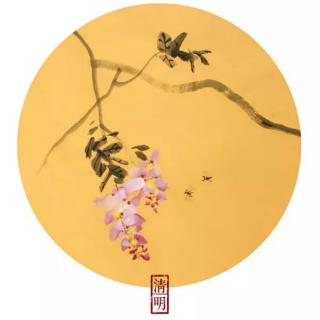
介绍:
“清明”是中国传统二十四节气(the 24 traditional Chinese solar terms)中的第五个节气,也是诸多节气中唯一一个与传统节日“清明节”(Tomb Sweeping Day)重合的节气。
因“清”“明”二字皆为描述天气的词语,所以“清明”的英语表达为Clear and Bright。
The words "clear" and "bright" describe the weather during this period. Temperatures begin to rise and rainfall increases, making it a crucial time for plowing and sowing in the spring.
“清明”一词中的“清”和“明”是用来描述这段时期的天气状况的。温度上升和降雨增多,这段时间成为春季耕作和播种的关键期。
plow:耕,犁
sow:播种
清明有哪些习俗呢?一起来看看吧。
祭祖
清明祭祖(worshiping ancestors)的传统可以追溯到古代,唐朝朝廷专门在此期间设定“节假日”以供子民祭祀先祖,该传统不断延续,在现代社会也有着举足轻重的影响。
Cleaning the tombs and paying respect to the dead with offerings are the two important practices to remember late relatives. Weeds around the tomb are cleared away and fresh soil is added to show care for the dead. The dead person's favorite food, wine and chopsticks are offered on their tombs, along with paper money.
扫墓和献上供品对逝者表示敬意,是两种纪念逝去亲友的重要习俗。为表示对逝者的关怀,墓边的杂草被清除并盖上新鲜的土壤。逝者最喜欢的食物、酒和筷子连同纸钱一起被供奉在墓边。
春游
清明时节除了祭祖,也是春游的好时光。有诗云:“梨花风起正清明,游人寻春半出城。”在温润的微风中,当循着草木的气息,外出寻找春天的足迹,强身健体又心情舒畅。
As trees turn green, flowers blossom, and the sun shines brightly, everything returns to life. It is a fine time to appreciate the beauty of nature. This custom can be traced back to the Spring and Autumn Period (770 – 476BC) and Warring States Period (475 – 221BC).
清明正值草木复苏,百花齐放,阳光普照,万物焕发生机之时,正是欣赏自然之美的大好时机。这一习俗可以追溯到春秋战国时期。
寒食节
寒食节(Cold Food Festival)是中国传统节日,在清明节的前一天,这天禁止生火,只能吃冷的食物。唐代诗人沈佺期在《寒食》一诗中写道:“普天皆灭焰,匝地尽藏烟。”读罢顿觉清冷之气扑面而来。
相传寒食节是“春秋五霸”之一的晋文公为纪念忠臣介子推而设立的。
蹴鞠
蹴鞠是古人清明时喜爱的一种游戏。“鞠”是一种内部塞满毛发的皮球。从陆游诗中“蹴鞠场边万人看”的盛景,可见这一运动受欢迎的程度。
Legend has it that the Yellow Emperor first invented it for training warriors. Later, Cu Ju was used by people to build up their bodies when they were unable to eat hot food during the Cold Food Festival.
相传蹴鞠是黄帝发明来训练战士的。后来,当人们不能在寒食节期间吃热食时,就利用蹴鞠来锻炼身体。
青团
清明吃青团在长江下游地区是非常流行的。软糯的外皮散发着艾草的清香,配上各色馅料,一口下去,满满的都是春天的气息。
People in the Jiangnan (south of the Yangtze River) region often eat this kind of green colored balls made from glutinous rice on Tomb Sweeping Day. The green color is from the juice of brome grass that is added in the rice.
江南地区的人们经常在清明节食用这种由糯米制成的绿色团子。由于糯米中混合雀麦草汁(也有使用艾草汁的),所以团子呈现出绿色。
清明节里话《清明》,让我们再回顾一下这首诗的英文翻译吧。
《清明》
(唐)杜牧
清明时节雨纷纷,
路上行人欲断魂。
借问酒家何处有?
牧童遥指杏花村。
A drizzling rain falls like tears on the Mourning Day;
The mourner's heart is going to break on his way.
Where can a wineshop be found to drown his sad hours?
A cowherd points to a cot 'mid apricot flowers.
(许渊冲 译)
大家还在听

